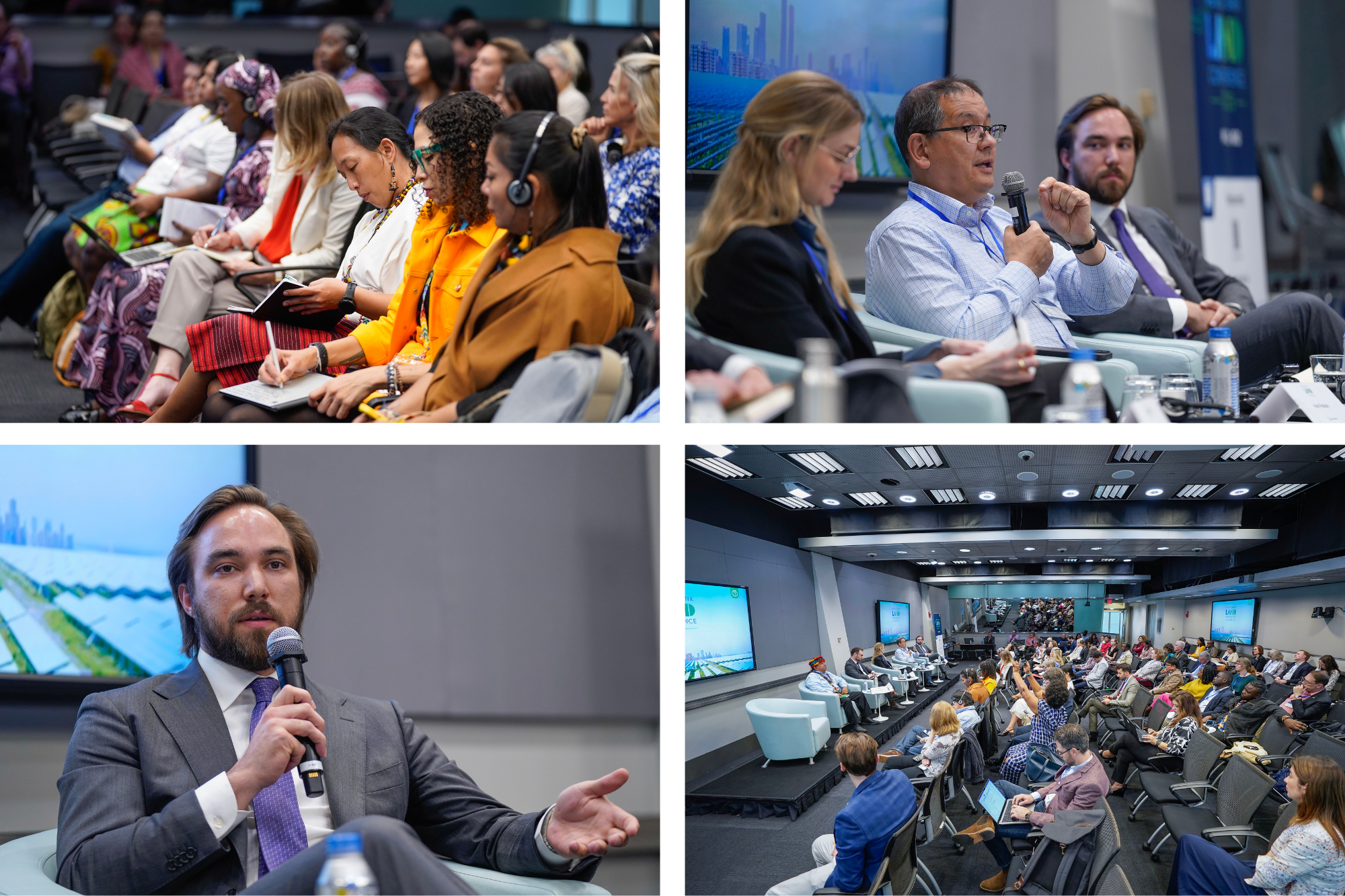


Insights from the World Bank’s Land Conference: Elevating First Nations Considerations in Responsible Investment
Earlier this month, Caleb Adams, Director in our ESG and Sustainable Investment team, was invited to speak at the World Bank’s 2025 Land Conference in Washington, D.C.
Caleb joined a panel on “Navigating the Energy Transition: A Just Path for Indigenous Peoples Amidst Growing Demands for Land and Mineral Resources” alongside global Indigenous leaders, civil society actors, and institutional stakeholders. Below are key reflections and takeaways from the discussion.
1. The Dhawura Ngilan Business and Investor Guides are a leading example of First Nations-Led Accountability Frameworks from Australia.
Achieving long-term alignment between investors, businesses, and First Nations rights requires institutions to embed cultural accountability within their decision-making structures. This means adopting governance models that centre on First Nations leadership and community-defined outcomes.
The Dhawura Ngilan Business and Investor Guides offer a leading example of this approach. This initiative was developed by First Nations leaders in response to the Juukan Gorge destruction, offering investors and businesses practical tools to engage with First Nations peoples more respectfully and effectively.
Several major organisations are actively supporting implementation, including the Minerals Councils of Australia, BHP, Lendlease, HESTA, and the Australian Retirement Trust (ART). Similarly, E&P is seeing growing interest among for-purpose and First Nations clients, seeking to endorse the Dhawura Ngilan Guides and ensure their governance and decision-making frameworks are implementation-ready.
This reflects a growing movement within Australia to align business and investment practices with First Nations-led accountability frameworks, and offers a strong example for international peers pursuing similar priorities.
2. First Nations Data and Disclosures Are the First Step to Scale
Frameworks like Dhawura Ngilan require diverse perspectives, including a First Nations worldview, to be successful. However, First Nations people remain chronically underrepresented in finance and business, both in Australia and globally:
- In 2025, just 0.3% of ASX300 board seats were held by First Nations people. 1
- A 2018 study found 0.4% of executive roles were held by First Nations people. 2
- 86% of the Australian mining sector is foreign-owned, meaning many investors may lack an understanding of local and cultural contexts. 3
Standardised reporting frameworks have proven effective in elevating important issues to the attention of Boards and C-suites – translating important principles into measurable data points, and extending beyond a reliance on specialist individuals to drive change.
The Australian Sustainable Finance Institute (ASFI) is helping to address this capability gap through its First Nations Disclosures project. Throughout 2025, this work will expand, developing consistent frameworks for corporates and financial institutions to disclose impacts, outcomes, and governance approaches relating to First Nations peoples and communities.
3. Impact Investment and Effective Institutions Are Key to Unlocking First Nations Leadership in the Land Economy
First Nations peoples hold recognised custodianship over nearly 70% of Australia’s land mass, including 20% under direct ownership. 4 These lands are a defining feature of the First Nations economy, carrying deep cultural, ecological, and economic significance. Despite this, examples of First Nations equity ownership in sectors like mining remain rare. The Gumatj Gulkula mine is a notable and leading exception. 5
Fellow panellist Mark Podlasly, CEO of the First Nations Major Projects Coalition (FNMPC) and a member of the Nlaka’pamux Nation, shared Canadian examples where Indigenous rights serve not only as safeguards but as levers for strategic co-ownership and long-term value creation. As examples, in British Columbia, clean energy projects must have a minimum 25% First Nations equity ownership; Hydro One (Canadian utility provider) provides a 50% equity stake to First Nations in new transmission projects over $100 million, while Greenstone Gold Mines (Canadian miner) includes co-ownership with Indigenous development corporations.
These arrangements are enabled by a growing ecosystem of purpose-built institutions. The First Nations Finance Authority (FNFA) has issued over C$2 billion in bonds to support Indigenous infrastructure and economic development. The Canada Infrastructure Bank’s Indigenous Equity Initiative helps reduce capital barriers through loan guarantees and concessional finance. The Nations Royalty Corporation, the world’s first Indigenous-owned mining royalty company, offers a model for long-term income from resource projects
Together, these efforts demonstrate how First Nations rights can form the foundation for co-ownership and economic development, not just viewed through the lens of cultural protection and harm reduction.

References
- Watermark Search International 2025 Board Diversity Index
- Australian Human Rights Commission – Leading for Change: A blueprint for cultural diversity and inclusive leadership revisited
- The Australia Institute: Australia’s small mining industry
- Australian Government Department of Agriculture, Fisheries and Forestry (ABARES): Australia’s Indigenous land and forest estate (2024)
- Gumatj Corporation: Gulkula Mining & Civil
Important Disclaimers
This communication was prepared by Evans and Partners Pty Ltd (ABN 85 125 338 785, AFSL 318075) (“Evans and Partners”). Evans and Partners is a wholly owned subsidiary of E&P Financial Group Limited (ABN 54 609 913 457) (E&P Financial Group) and related bodies corporate.
This communication is not intended to be a research report (as defined in ASIC Regulatory Guides 79 and 264). Any express or implicit opinion or recommendation about a named or readily identifiable investment product is merely a restatement, summary or extract of another research report that has already been broadly distributed.
The information may contain general advice or is factual information and was prepared without taking into account your objectives, financial situation or needs. Before acting on any advice, you should consider whether the advice is appropriate to you. Seeking professional personal advice is always highly recommended. Where a particular financial product has been referred to, you should obtain a copy of the relevant product disclosure statement or other offer document before making any decision in relation to the financial product.
The Financial Services Guide of Evans and Partners contains important information about the services we offer, how we and our associates are paid, and any potential conflicts of interest that we may have. A copy of the Financial Services Guide can be found at www.eandp.com.au. Please let us know if you would like to receive a hard copy free of charge.
Internship Program - Expression of Interest
Fill out this expression of interest and you will be alerted when applications open later in the year.
Help me find an SMSF accountant
Begin a conversation with an accountant who can help you with your self-managed super fund.
Media Enquiry
Help me find an adviser
Begin a conversation with an adviser who will help you achieve your wealth goals.
Subscribe to insights
Subscribe to get Insights and Ideas about trends shaping markets, industries and the economy delivered to your inbox.
Start a conversation
Reach out and start a conversation with one of our experienced team.
Connect to adviser
Begin a conversation with one of our advisers who will help you achieve your wealth goals.
You can search for an adviser by location or name. Alternatively contact us and we will help you find an adviser to realise your goals.


